Tiger
![]()
The title of this article is ambiguous. For other meanings, see Tiger (disambiguation).
The tiger (Panthera tigris) is a big cat common in Asia. It is distinctive because of its size and characteristic dark stripe pattern on a golden yellow to reddish brown background. There are eight to nine subspecies, distinguished as mainland and island subspecies, which differ in appearance. The greatest differences are between the small, contrasting Sumatran tigers and the large, paler-colored Siberian tigers, also known as Amur tigers. As typical subspecies between the two extremes, the Indian Bengal tiger and Indochinese tiger are considered. The extinct Balitiger originally represented the smallest subspecies. The Siberian subspecies is the third largest land-dwelling predator after the polar bear and brown bear.
Sumatratiger reach an average head-torso-length of approximately 140 cm, a tail-length of approximately 60 cm and a weight of approximately 120 kg (male) respectively 90 kg (female). Male Siberian tigers, on the other hand, reach a head-torso length of up to 200 cm, possess an approximately 90 cm long tail and weigh approximately 250 kg. Siberian tiger females are with approximately 150 kg of body weight clearly smaller than the males.
Tigers usually live solitary and feed mainly on larger ungulates. They inhabit a wide variety of habitats, such as tropical rainforests, grasslands, swamps or boreal forests. Originally, the tiger was spread from the Caucasus and the Far East of Russia over East-China, the Indian subcontinent and rear-India up to Sumatra, Java and Bali. Today, the tiger has disappeared from large parts of its former distribution area. Three subspecies are already extinct. In total, it is estimated that 3000 to 5000 wild tigers remain, most of which are now confined to isolated protected areas. The species is classified by the IUCN as "critically endangered" (Endangered).
Features
Colouring and coat
The tiger is not to be confused with any other big cat due to its striking stripe pattern. Like the fur coloring with the leopard and jaguar (rosettes) or lion (sand-colored fur), the stripes of the tiger serve the camouflage in combination with the basic color of the fur. Compared to the regular stripes of a zebra, the irregular and partly broken stripes of the tiger are an optimal adaptation to the background of its habitat. The special coloring makes it possible to hide in the vegetation or on the ground. Thus, the black stripes on the golden-yellow or red-orange basic fur color in the bamboo thicket, for example, appear like shadows in the sunlight, and in arid grasslands, the tiger merges with the blades of grass and smaller bushes. In the total perception, the big cat almost "blurs" in its surroundings, and the tiger remains undetected for its prey for a long time. The Siberian tiger is to be made out in the winter only on tree-free, snowy surfaces, whereas the forest gives him again a perfect camouflage, since many trees and bushes in the taiga do not throw off the dry and from the autumn colored leaves.
"The coloration provides the tiger with complete protection. When he moves in the taiga among the bushes and the arid foliage, the black, yellow, and white colors flow entirely into one another, and the animal assumes a monotonous brown-gray color. Especially in autumn, among the orange and red vine leaves and the dry yellow fronds of the bracken, interspersed with many blackish stalks, the tiger can scarcely be distinguished even at a closer distance."
- Vladimir Arsenyev
The basic color of the upper side varies depending on the subspecies between golden yellow and red-orange. The underside as well as parts of the face and the insides of the legs are white or light beige. The back of the ears is black and has a clearly conspicuous white marking. Striking dark horizontal stripes extend from the head over the entire rump to the tip of the tail. The tail appears ringed as a result. The legs are striped in similar manner, whereby the front legs show, however, often a clear stripe reduction. The different subspecies of the tiger differ partly considerably in the expression of the fur coloring. The tigers of the Siberian subspecies are usually the lightest colored. However, many Bengal tigers from north or central India are almost of equally light color. The tigers of Indonesia and the Malay Peninsula are usually the darkest and most powerfully colored. Intermediary in the coloring are or were obviously the South Chinese and Caspian tigers. The tigers of the northern populations distinguish themselves beyond that by a larger portion of the white areas. Tigers from the south of the distribution area possess usually many very dark and often also quite wide stripes that often disintegrate at their ends in groups of spots. Such stains occur more rarely with northern tigers. The Caspian tigers from front Asia had relatively narrow, thin stripes on the other hand as a rule. Bengal tigers, which can be quite bright from time to time, differ from old Siberian tigers approximately by the fact that their flank stripes are intensely black, while they are usually gray or brown with the northern form. However, these geographical differences are opposed by a high variability within the populations. The nose of the tiger is generally pinkish-red, but shows with increasing age increasingly black points.
The fur is relatively short with most forms, with the Siberian tigers because of the cold climate, however, densely and long-haired. The length of the hair of a Bengal tiger is in the summer with approximately 8 to 15 mm, with what the hair is longer at the belly with 20 to 30 mm. In contrast, the hair of a Siberian tiger measures 15 to 17 mm on the back and 25 to 45 mm on the belly in summer. The Bengal Tiger's back hair measures 17 to 25 mm long in winter, and the belly hair measures 25 to 40 mm long. The hair of the Siberian tiger reaches a length of 25 to 40 mm on the back and 70 to 105 mm on the belly during the cold season. The body-hairs of the Sumatratiger become only approximately 10 to 15 mm long. However, the long neck-mane and the distinctive whiskers are conspicuous with the males of this subspecies.
At least in zoological gardens, all subspecies develop a winter coat of top coat and undercoat, with hair length and density varying between subspecies and climatic conditions. The summer coat is much shorter and less dense, especially in the Siberian subspecies. The hair density of about 1800 hairs per square centimeter in Bengal tigers and 3200 in Siberian tigers in winter is comparable to that of leopards, although lynxes reach much higher hair densities of up to 9000 per square centimeter. In spring, the long winter coat is replaced by a short summer coat. The impression of a second hair change with northern tigers in the autumn might be explainable by the fact that the summer fur grows out longer in the autumn. Whether tigers in India also carry out a hair change is not quite clear. Also the claws are changed regularly. They first peel off in layers and then fall off. During this time, the tiger often scratches in soft tree bark.
Colour variants
There are, as with most vertebrates, deviant color variants whose peculiarity is less relevant from a biological than from a cultural-historical point of view, since they were bred by local rulers as preciousnesses and are still considered attractions in shows (for example, Siegfried and Roy). White tigers are particularly well known. These animals are not true albinos, but "partial albinos" (leucism), recognizable among other things by the fact that they lack the red eyes of an albino, instead the eyes are usually blue. Most of these white tigers have dark stripes; rarer are white tigers without stripes. Many white tigers known today trace their ancestry to a male captured in the Indian state of Madhya Pradesh in 1951. Since the color variation inherits recessively according to the mendelian rules, inbreeding was a much used means for the breeding of white tigers at the beginning. Contrary to what is often claimed, however, white tigers are not fundamentally a product of inbreeding. Since then, no white tigers have been observed in the wild. Another color variant that is also very rare in the wild is the so-called redling (Rufino), in which the black pigment of the stripes is missing. Such an animal is described approximately from the Elbursgebirge, another from Assam. Such colored animals appeared later also in the offspring of tigers in captivity and are also known under the name "golden tigers". They possess a pale yellow basic color with light brown streak. Tigers of this color variant are bred similar to white tigers particularly in amusement parks and with showmen. The color play types that live today in captivity go back above all to Bengal tigers. Partially, Siberian tigers were in-crossed thereby, why the often propagated "breeding successes" do not represent any contribution to the protection of these subspecies.
Besides white and golden tigers, reports exist about almost black or blue-gray copies. Besides, there are further individual peculiarities in the fur pattern of individual tigers. Thus, some tigers tend to a strong stripe reduction in particular in the area of the front body part.
Height
The size varies greatly between the subspecies. Within a subspecies, the males are recognizably larger and heavier built than the females. Large male tigers of the Siberian or Indian subspecies usually reach a head trunk length of 2 m maximum. In addition, a tail of at least 90 cm. The total length thus lies with approximately 3 m. Females of the Bengal tiger are with tail somewhat over 250 cm long, females of the Amur tiger approximately 260 cm long, with what approximately 165 to 178 cm are allotted to the head trunk length. Sumatran tigers, which represent the smallest living subspecies, reach a total length of 240 to 250 cm (males) or 215 to 230 cm (females). The head-torso-length amounts to 155 to 170 cm (male) respectively 145 to 155 cm (female). The smallest form of the tiger, the extinct Balitiger, might have reached a total length of approximately 220 to 225 cm with male animals and a total length of approximately 190 to 200 cm with female animals.
The withers-height of Siberian tiger-males amounts to in the stand approximately 97 to 105 cm. Males of the Bengal tiger and the Indochinatiger are somewhat smaller with approximately 90 to 100 cm withers. Males of the Sumatratiger measure against it only about 75 to 79 cm, that of the Chinese tiger about 82 to 86 cm. Female Amur, Bengal and Indochina tigers become approximately 78 to 87 cm high. Female Sumatratiger reach a withers-height of only 66 to 68 cm.
Occasionally, also data exist about tigers whose size clearly go beyond the known spectrum. For example, maximum head-torso lengths of 290 cm or total lengths of almost 4 m are reported for tigers. However, such extreme values should be largely based on exaggerations, estimations and/or on measurements with which the length of the animal over curves, thus over all body bends measured, was determined. In addition, skins can be extremely stretched, which can lead to very high values when measured. The longest Caspian tiger that became known is a male that was shot in 1939 at the Ili river and had a length of 295 cm measured in straight distance from the nose tip to the tail tip (between pegs). The head-torso length accounted for 197 cm and the tail for 98 cm. One of the largest credibly surviving total lengths between pegs for a Bengal tiger is 312.5 cm. The average total length of large male Indian tigers is about 280 cm. A huge Siberian male tiger, which came from the Sichote-Alin area and died in the Duisburg Zoo in 1965, measured 319 cm between pegs, of which 99 cm was the tail. The biggest credibly delivered value for the total length of a Siberian tiger amounts to 350 cm over curves, from which a real total length over pegs of approximately 330 to 335 cm results. The animal was killed 1943 in northeast China.
With an average total length of about 260 to 270 cm and rarely over 285 cm, male lions generally lag behind the large subspecies of the tiger. Thus, the tiger can be considered as the biggest cat species of the world. The biggest credibly delivered length measures for lions lie with approximately 305 to 310 cm of total length between pegs, measured at an animal from the area north of the Victoria lake. This is also somewhat below the values for the largest known Siberian tigers.
Body weight
Adult males of the Sumatran tiger weigh about 100 to 140 kg, females between 75 and 110 kg. Male Bengal tigers in Nepal weigh about 200 to 240 kg, females about 125 to 160 kg. The highest, credibly handed down value for the weight of a Bengal tiger is 258 kg according to Vratislav Mazák. The animal was shot in the Terai in India. Another large male of this subspecies weighed 256 kg. The average weight of Indian male tigers is likely to fluctuate around 190 kg, according to Mazák. The highest credible value for a Caspian tiger is 240 kg and was obtained from an animal shot on the Ili River. The highest value for a Siberian tiger is at 306.5 kg, which represents the highest credible documented value of a tiger at all. It was a male named Circa that was captured as a cub in the Ussuri region and died at the age of ten in a menagerie. Data about Siberian tigers with a body weight of clearly over 300 kg are not verifiable. Mazák gives as an average value for the body weight of full-grown Siberian tigers about 230 kg. The extinct Balitiger reached presumably only a body weight of 90 to 100 kg (male) respectively 65 to 80 kg (female). Java tigers were somewhat larger with a body weight of approximately 130 to 135 kg (male) and approximately 100 kg (female).
Skull and dentition
Like other big cats, the tiger also has a round pupil. The iris is usually yellow. The massive skull of the tiger is more elongated than that of small cats, as with other big cats. It is similarly large as that of the lion and hardly to be distinguished from a lion skull. In the construction of the nose bone, smaller differences exist, as well as in the construction of the lower jaw. This is rather concave with the tiger at the underside while that of the lion is rather convex bent. The skull length amounts to 350 to 360 mm on average with big tiger males. The skull lengths of bigger female tigers lie with approximately 290 to 310 mm, whereby sumatratiger only skull lengths of 295 to 340 mm (male) respectively 263 to 293 mm (female) show. The skull length of full-grown, male Balitiger amounted to only approx. 295 mm, that of the females approx. 265. The brain of the tiger holds approx. 250 to 300 cm³.
The permanent dentition contains 30 teeth, with the dental formula corresponding to that of other recent cats:
The first upper molar (cheek tooth) is very small or often missing completely. The same applies to the first upper premolar. Most conspicuous are the canines (canini), which in the upper jaw protrude up to 70 mm from the gum. The lower canines are slightly shorter. The fangs are placed by the fourth upper premolar and the first lower molar and are 34 to 38 mm and 26 to 29 mm long respectively in adult tigers.
Skeleton and internal organs
The skeleton is a typical cat skeleton and hardly distinguishable from that of a lion. Only at the humerus (upper arm bone), slight differences are to be made out. The tiger possesses a retractable, sickle-shaped claw at each toe of the front paw. These can reach 80 to 100 mm at the outside and are hidden in the resting state in skin sheaths. At the rear foot, the visible four toes are also provided with retractable claws. The spinal column of the tiger consists of 55 to 56 vertebrae, the rib cage of 13 rib pairs. A tiger heart weighs about 600 to 1100 g, the intestine measures about 7 m. Amur tigers usually put on a thick layer of fat in winter, the thickness of which is about 5 cm on the flanks.
Chromosome set
The chromosome set of the tiger consists as with other old-worldly cats of 18 autosome pairs and two sex chromosomes, what results in a diploid set of 38 chromosomes.
Track
The step length of the tiger varies between 70 cm with males and 60 cm with females. The size of the paw prints depends strongly on the underground. The front paws of a very big male tiger leave an imprint of about 14 to 17 cm length and 13 to 16 cm width in moist clay. The tread marks of female tigers measure 12 to 14 cm in length, 11 to 13 cm in width under these conditions. In the snow, in particular in the new snow, the tracks can turn out clearly bigger.
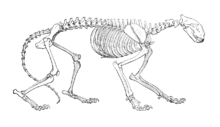
Drawing of a tiger skeleton

Mouth of a young Siberian tiger
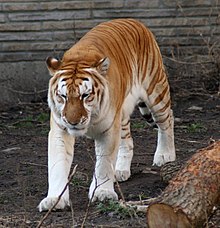
Tiger with missing stripe pigment

White tiger

Bengal tiger head
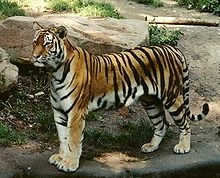
Female amur tiger in summer coat
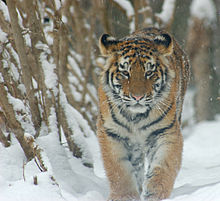
Amur tiger

Sumatran
Subspecies
Up to nine subspecies are currently distinguished, three of which are already extinct. The subspecies status of P. t. jacksoni on the Malay Peninsula is disputed; in the following listing it is listed as a distinct subspecies. Genetic analyses support the subdivision of extant forms into six distinct subspecies according to the scheme presented here. Thereby, the subspecies of the Asian mainland seem to differ relatively little from each other, while relatively big genetic differences exist to the tigers of the island Sumatra. The tigers of the island of Sumatra were probably separated from those of the mainland between 6,000 and 12,000 years ago, when the sea level rose at the end of the last cold period and the former land bridge sank. Notably, the differences between the extinct Caspian tiger and the Amur tiger are so slight that the two should possibly be combined into one subspecies.
Since 2015, after the examination of more than 200 skulls by an international team of researchers, it has been discussed whether only a subdivision into two subspecies should be made, as only the Sunda tiger (Panthera tigris sondaica) from the Indonesian islands of Sumatra, Java and Bali and the mainland tiger (Panthera tigris tigris) would be genetically clearly distinguishable.
Mainland Tiger
- Siberian tiger, Amur or Ussuritiger (P. t. altaica); the biggest subspecies of the tiger was spread once far over the eastern Siberia, the Manchuria and Korea. The fur is relatively bright and particularly long and dense. By massive re-enactment, the continuance was reduced in the meantime on about 30 animals in the Chinese-Russian and Chinese-Korean border-area; this continuance has grown up in the meantime again on about 350 to 400 individuals, but still strongly endangered.
- South Chinese tiger (P. t. amoyensis); medium-sized subspecies, somewhat smaller than Bengal or Indochinatiger, the coloring is more intense, the white portion smaller. The stripes are usually very dark and relatively far apart. Once widespread in large parts of China from the 38th to 40th° north latitude southwards to the northern border areas of Yunnan, Guangxi and Guangdong. Today, a few specimens, if any, still live in the mountains of Guangdong. These possible remnant populations are unlikely to have realistic chances of survival, even if conservation measures take effect, as such a small population is unlikely to survive (see inbreeding depression). Populations in zoos, and thus a breeding program, were established late and are limited almost exclusively to Chinese zoos. However, the zoo population increased from 57 to 72 animals between 2005 and 2007. Reintroductions with zoo-born animals are planned. The Save China's Tigers Foundation is working to breed and habituate South China tigers to hunt outside of China in a reserve in South Africa, with the aim of reintroducing them to their original habitat.
- Bengal tiger, Indian tiger or Royal Bengal tiger (P. t. tigris); the second largest subspecies. Coat coloration overall relatively variable, but usually darker than in the Amur tiger and lighter than in the southeastern subspecies. Stripes are usually very dark. Originally distributed from the Indus lowlands in Pakistan across the Indian subcontinent to Bengal, Assam and the northwestern parts of Myanmar. Thereby, certain genetic differences exist within the subspecies, especially the tigers of the north differ from other Bengal tigers. Also the Bengal tigers at the west end of the subspecies area show moderate genetic peculiarities. Above all, the animals of the Sariska national park, where tigers were exterminated in the year 2004, resembled genetically very strongly those from the neighboring Ranthambhore national park. This makes the tigers from Ranthambore the best candidates for a possible future reintroduction in Sariska. Today, the Bengal tiger still occurs in isolated remnants in India, Bangladesh, parts of Bhutan and Nepal, as well as in western Myanmar. Today it is assumed that there are less than 2500 Bengal tigers living in the wild, of which by far the largest part, about 1400 (as of 2008), live in India. The significantly higher population figures of the censuses from 2001 to 2002 cannot be directly compared due to the different methods used. However, the more recent results are considered more reliable. The Bengal tiger is considered threatened, but is less endangered than the other subspecies; conservationists have repeatedly warned of the Indian tiger's impending extinction in India and neighboring states. Despite an international ban, criminal organizations operate a vibrant trade in tiger pelts.
- Indochinese tiger, Indochina tiger, also hind Indian tiger or Corbett tiger (P. t. corbetti); somewhat smaller than the Bengal tiger, basic coloring somewhat darker, the usually very dark stripes often go over into spots. The subspecies is distributed in mainland Southeast Asia, where it occurs from the Chinese provinces of Yunnan, Guangxi and Guangdong, and northern Myanmar southward to the Malacca Peninsula. There are probably only 350 specimens left, surviving in Cambodia, Thailand, Myanmar, Laos and small numbers in Vietnam, among other places. The Malay Peninsula population may represent its own subspecies and is listed separately as the Malayan Tiger.
- Malayan tiger, Malaysian tiger or Jackson tiger (P. t. jacksoni); widespread on the Malay Peninsula and also highly endangered; the independence of this subspecies, which was previously included in the Indochinese tiger, is still disputed. There are genetic differences between the Malay Peninsula populations and the more northern populations, but there do not appear to be any differences in coat pattern or skull structure. Also, the populations transition smoothly northward into those of the Indochinatiger. According to the latest IUCN information, there are about 250 specimens native to the Malay Peninsula.
- Caspian tiger, Persian tiger or Turantiger (P. t. virgata); an extinct subspecies, which stood out above all by the usually many, narrow stripes from the Amur tiger. The stripes were usually quite light, the fur relatively long. Originally wide distribution from Anatolia over Iran and Central Asia to Mongolia. Early on, the Caspian tiger was extirpated from much of this area; it is now extinct both in the wild and in captivity; the last held in southwest Asia until the early 1970s. Recent molecular biology studies indicate that the subspecies is identical to the Siberian tiger and that the range of the two populations may have been separated only by humans.
Sunda Tiger
- Sumatran tiger (P. t. sumatrae); relatively small, contrasting coloured subspecies, the stripes often decay to spots. At the same time smallest of the surviving subspecies. The long whiskers of the males are conspicuous. The Sumatran tiger is the only island subspecies to have survived to the present day; there are still 400 individuals in remote regions of Sumatra. The IUCN lists the subspecies as "Critically Endangered".
- Java tiger (P. t. sondaica); still smaller than the Sumatran tiger and similarly dark colored. Stripes very narrow and numerous. Once common on Java, the most densely populated island of Indonesia, this subspecies was last recorded in the 1970s and is considered extinct.
- Balitiger (P. t. balica); the smallest subspecies. Even darker colored than Sumatratiger and most Javatigers. Stripe pattern rather broad and more similar to that of the sumatratiger than to that of the javatiger. Frequent lines of darker spots between stripes. Originally endemic to Bali, the subspecies was extirpated by excessive hunting and habitat destruction in the 1940s.
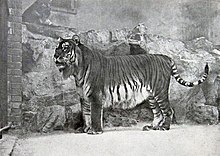
Caspian tiger
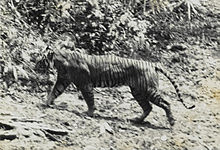
Javanese
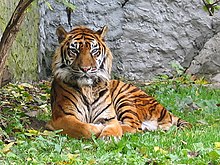
Sumatran
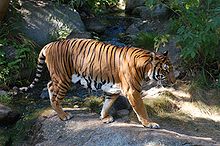
Indo-Chinese tiger

Bengali

South China tiger

Amur tiger
Questions and Answers
Q: What is the scientific name of the largest living cat?
A: The scientific name of the largest living cat is Panthera tigris.
Q: What is the feeding habit of the tiger?
A: The tiger feed by hunting.
Q: Where does the tiger live?
A: The tiger lives in Asia, mainly in India, Bangladesh, Bhutan, Nepal, Myanmar, Thailand, Cambodia, Vietnam, Malaysia, Indonesia, China, Korea and Siberian Russia.
Q: What is the size of the cat family, Felidae?
A: The cat family Felidae is the largest living family of the cat.
Q: Are tigers social animals?
A: No, tigers are solitary animals.
Q: In which country can you find a Siberian tiger?
A: You can find a Siberian tiger in Siberian Russia.
Q: What is the largest living member of Felidae?
A: The largest living member of Felidae is the tiger.
Search within the encyclopedia
